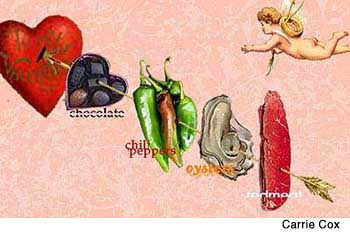Can food put us in the mood?
By Rebecca Chastenet de Géry

February 14 is a day to celebrate love, lust, romance, and the means to make these things happen. Sexy negligees, candlelight, and flowers may be a part of your Valentine's Day strategy, but in mapping your seduction, don't fail to consider the power of food.
Sexual desire, science tells us, begins as a stimulus in the hypothalamus of the brain -- the same place our hunger for food begins. It's no wonder, then, that for centuries people have sought nourishment for the stomach that simultaneously caters to their carnal cravings.
Aphrodisiacs, substances that stimulate or intensify the sex drive, get their name from Aphrodite, the Greek goddess of love. The Chinese were perhaps the first to develop a technique for determining the aphrodisiac quality of different foods, and Chinese culinary history is rich with recipes for libido-enhancing powders, salves, and potions. In China, edible aphrodisiacs such as ginger have been a preamble to sex for nearly 5,000 years.
Over time, modern Western science has debunked much of the mystery behind many stimulating foods by informing us that some aphrodisiacs may stir us sexually simply because they resemble sexual organs or have evident "masculine" or "feminine" features -- asparagus, strawberries, bananas, peaches, and artichokes among them. Other aphrodisiacs, such as caviar (sturgeon eggs), probably derive their believed powers because they are unmistakable symbols of fertility, scientists conclude.
It should be noted, however, that many of the foods long considered aphrodisiacs might indeed make our bodies feel good. As Amy McLaughlin, a registered dietician, explains, "Many foods appreciated for their ability to stir our passions give us a lift because they contain generous amounts of vitamins and minerals, which provide the body with energy." Consider, for example, shellfish. Believed for centuries to harbor amorous properties, most shellfish are high in phosphorus, calcium, iodine, iron, vitamin B, and glycophosphates and are low in fat -- so they are predisposed to give us a physical boost. Honey, with its luscious, dripping quality, has a gloriously sensual history. Hippocrates prescribed it for sexual vigor, Indian bridegrooms receive it on their wedding day, and it is celebrated in the Kama Sutra. Honey is, quite simply, sugar that our body converts into quick energy.
But beyond vitamin, mineral, or sugar levels, are there any foods that contain a natural chemical component that directly enhances sexual arousal? McLaughlin says certain foods do indeed contain chemical agents that may have physiological effects on the body, effects that lovers may feel as arousal. They include the following:
- Oysters. Legend has it that Casanova slurped oysters on the half shell prior to his trysts, a move that may have been to his amorous advantage because of the mollusks' elevated zinc content. Zinc is essential for the production of testosterone, a hormone that spurs the sexual appetite in both men and women.
- Chili peppers and cayenne pepper. These contain high amounts of vitamin C, an agent that excites the body by stimulating circulation. The consumption of peppers may result in an increased heart rate and sweating, physiological effects that also occur during sexual attraction.
- Beef. The Japanese and Chinese have long been privy to the bovine's powers, serving thin strips of beef blanketed with oyster sauce in a kind of "double whammy." McLaughlin notes that high-protein foods such as beef flood the bloodstream with the amino acid tyrosine. The chemicals made from tyrosine -- dopamine and norepinephrine -- trigger brain cells that enhance mental alertness and concentration.
- Chocolate. This sweet treat may have become the favored Valentine's Day gift because it contains caffeine and theobromine, chemicals that stimulate the central nervous system, as well as phenylethylamine, a chemical some scientists believe gives us the same sensation we feel when we are in love.
So it's more than folklore that has lent fame to certain aphrodisiacs; some of these foods cause physiological reactions that can put you in the mood. And besides, now is no time to doubt their power of persuasion. So put on your apron and whip up a romantic repast -- your valentine's palate and pleasure are waiting.

